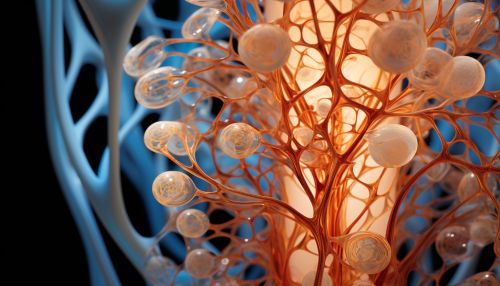Olfactory bulb
Anatomy and Structure
The olfactory bulb is a neural structure of the vertebrate forebrain involved in olfaction, the sense of smell. It sends olfactory information to the rest of the brain from the nasal cavity. Located in the forebrain of vertebrates, it is a paired structure, with one located in each of the left and right hemispheres. It is a critical component of the olfactory system, which processes smells and is part of the limbic system.


The olfactory bulb is composed of several types of cells and layers. The main cell types include mitral cells, tufted cells, periglomerular cells, and granule cells. The layers, from the surface moving deeper into the bulb, are the olfactory nerve layer, the glomerular layer, the external plexiform layer, the mitral cell layer, the internal plexiform layer, and the granule cell layer.
Function
The primary function of the olfactory bulb is to receive sensory input from the olfactory receptors in the nasal cavity and transmit this information to the higher regions of the brain. The olfactory bulb processes the sensory data and performs the initial stages of the processing of smell. It is also involved in many other functions, such as the modulation of memory, emotions, and behavior.
Olfactory Transduction
Olfactory transduction is the process by which smells are converted into a signal that can be processed by the brain. This process begins when odor molecules bind to receptors on the cilia of olfactory sensory neurons in the nasal cavity. This binding triggers a signal transduction pathway that results in an action potential. The action potential travels along the axon of the sensory neuron and into the olfactory bulb, where it is processed and sent to higher regions of the brain.
Olfactory Coding
Olfactory coding is the method by which the olfactory system encodes odor information for the brain to interpret. Each odor molecule has a specific shape that fits into a corresponding receptor on the olfactory sensory neurons. The combination of activated receptors represents the specific smell. This information is sent to the olfactory bulb, where it is processed and sent to the olfactory cortex for further processing and interpretation.
Olfactory System
The olfactory system is the sensory system used for smelling. It includes the olfactory epithelium in the nasal cavity, the olfactory bulb, the olfactory tract, and the olfactory cortex. The olfactory system is unique among the sensory systems in that it has a direct connection to the brain, allowing for a fast and detailed analysis of smells.
Clinical Significance
The olfactory bulb has significant clinical relevance. Damage to the olfactory bulb can result in a loss of the sense of smell, a condition known as anosmia. This can be caused by head trauma, viral infections, or neurodegenerative diseases such as Alzheimer's disease or Parkinson's disease. The size and functional connectivity of the olfactory bulb can also be affected in certain psychiatric disorders, such as schizophrenia and depression.
Research
Research on the olfactory bulb has provided insight into many aspects of neuroscience, including neural development, synaptic plasticity, and neural coding. The olfactory bulb is also a model system for studying neurogenesis, as it is one of the few regions of the adult brain where new neurons are continually generated.
